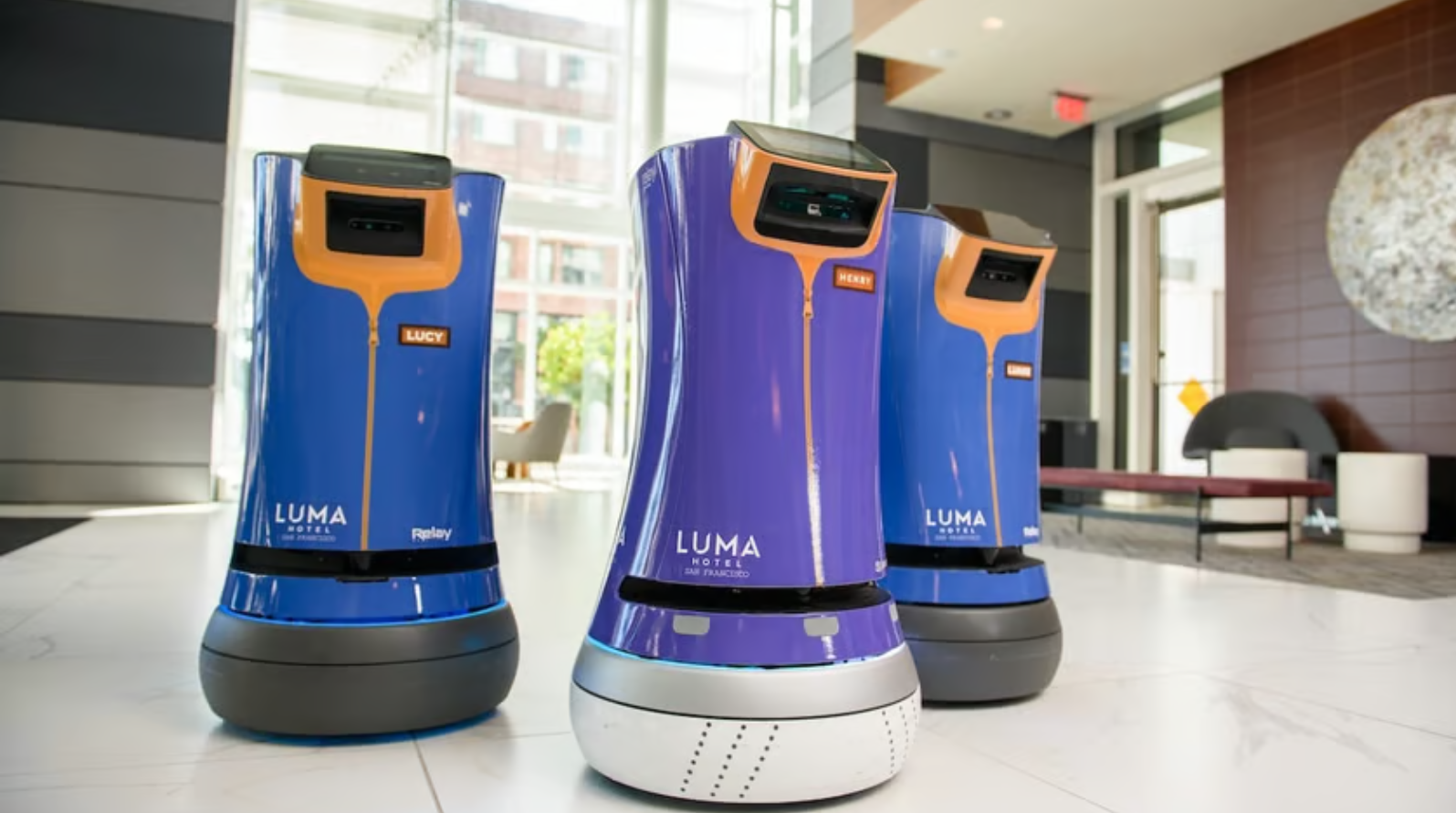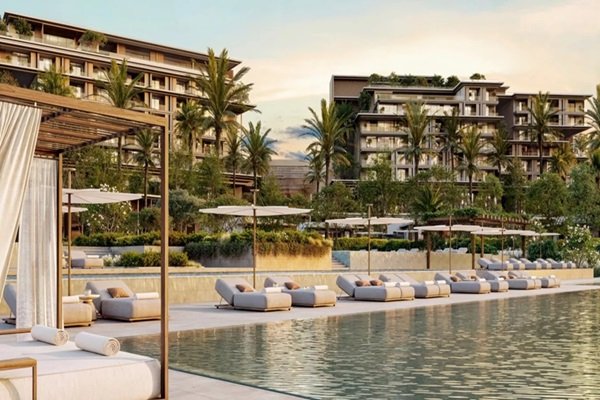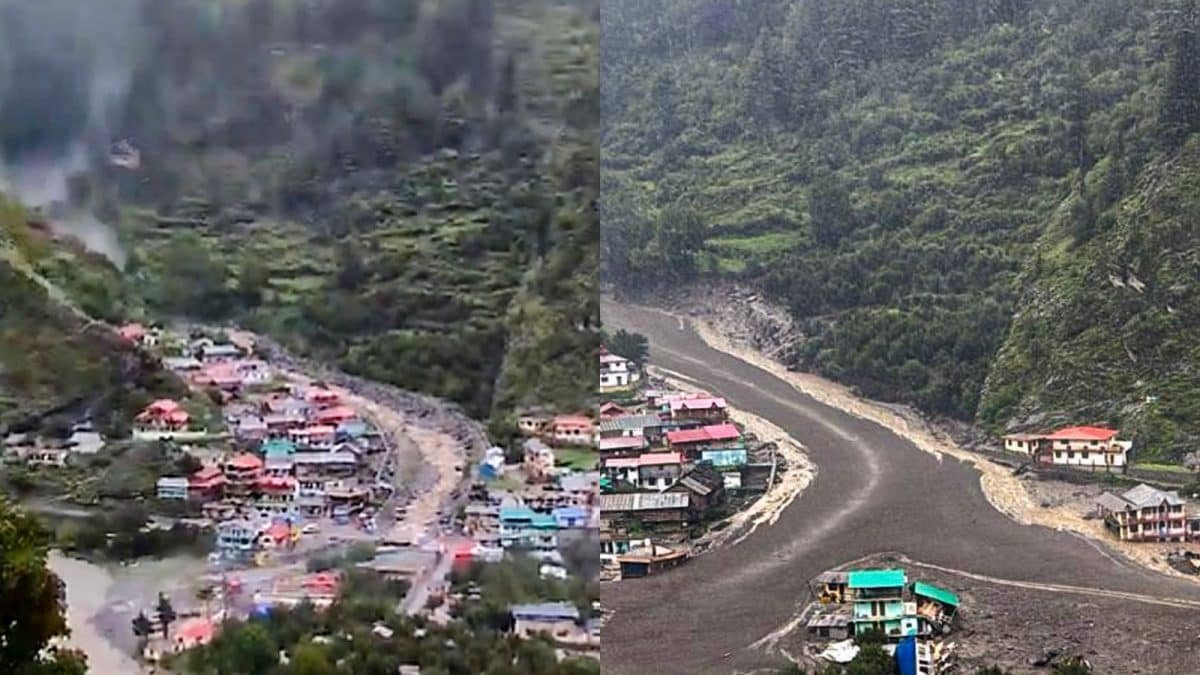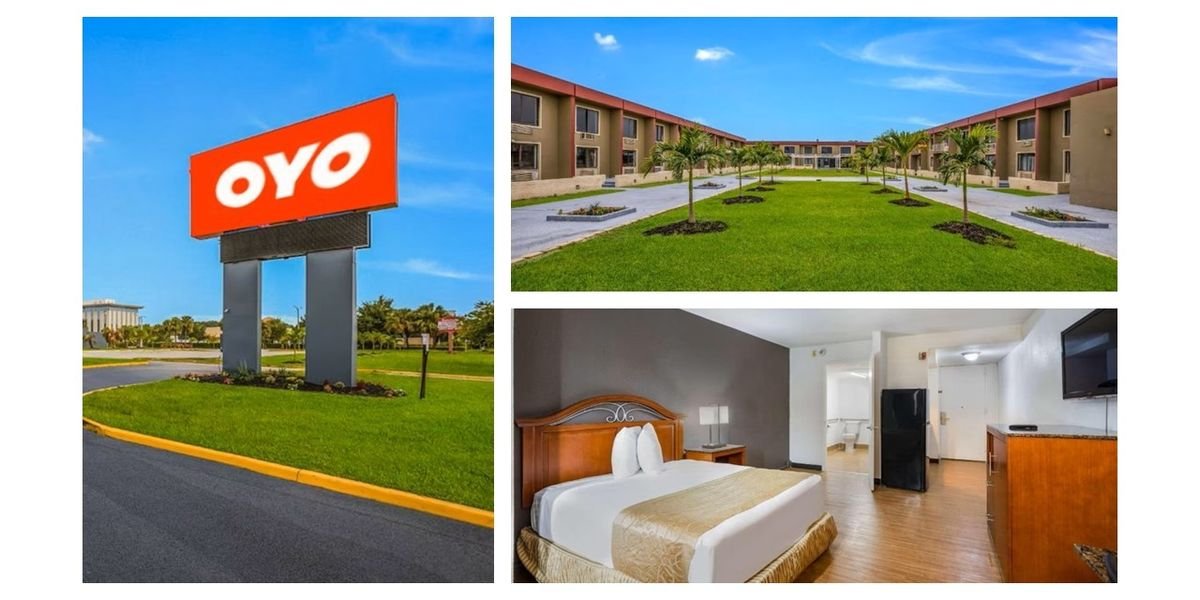Hotels & Accommodations
Hotels Embracing Robots Must Focus on Planning and People First |

By Orit Naomi, HTN staff writer – 8.2.2025
A new research study offers a comprehensive look at how hotels can successfully implement robotic process automation, or RPA, in their operations. The research is one of the most in-depth qualitative analyses to date on the subject. It focuses on hotels in China and Pakistan, using thematic analysis to identify what industry professionals see as the most important factors at each stage of automation.
RPA refers to software bots that mimic human interactions with digital systems, often handling repetitive tasks like invoicing, check-ins, and updating guest information. These bots use the same applications that human workers do, often navigating user interfaces with keyboard and mouse functions to complete predefined actions. The technology has become increasingly relevant in the hospitality sector, where cost pressure, labor shortages, and rising guest expectations demand smarter operational strategies.
The study, Critical Success Factors for Implementing Robotic Process Automation in the Hotel Industry, is based on 17 semi-structured interviews with hotel executives and IT professionals working in both countries. These individuals, who held titles ranging from IT manager to general manager, were selected specifically for their experience with RPA planning or implementation. Interviews were conducted in the participants’ native languages, Urdu and Chinese, and analyzed using NVivo 14, a widely used tool for organizing and interpreting qualitative data.
What makes this research particularly significant is its phased approach to identifying success factors. Instead of viewing RPA implementation as a single moment of technological change, the researchers broke the process into three stages—before, during, and after implementation—and examined what factors contributed most to success at each point. These factors, often referred to in the study as critical success factors (CSFs), help explain not only why some hotel automation efforts thrive but also why others falter.
In the planning stage, hotels that succeeded with RPA were those that began with clear and well-defined goals. These goals were often tied directly to strategic business outcomes, such as reducing wait times at check-in, lowering labor costs, or increasing accuracy in guest billing. Without this level of specificity, hotels ran the risk of launching automation projects that didn’t align with broader organizational priorities.
Another essential step was identifying the right processes to automate. High-volume, repetitive tasks like entering reservation data or handling invoices were generally the most suitable for RPA. But this wasn’t just about identifying bottlenecks. It also involved deep process mapping, where hotel teams examined each workflow in detail to determine where automation could make the biggest impact.
A third major component was stakeholder alignment. RPA often affects multiple departments, from front-of-house operations to back-office finance teams. In hotels where the implementation went smoothly, there was early and active buy-in across teams. Managers engaged their staff in discussions about how automation could support their work rather than replace it, which helped to mitigate resistance and increase cooperation.
Feasibility studies also played a role in this early phase. Hotels that took the time to assess the technical and financial implications of RPA before implementation were better prepared for the challenges that followed. These assessments helped them anticipate the return on investment and identify any weak links in their IT infrastructure. A final element of the pre-implementation phase was vendor selection. Rather than simply choosing the flashiest or cheapest provider, successful hotels took a rigorous approach to evaluating RPA vendors. They looked for partners who understood the hospitality industry and had proven experience with similar projects.
Once implementation began, a different set of success factors came into play. One of the most consistent themes was the value of a dedicated project team. These teams, typically made up of cross-functional members from IT, operations, and management, were responsible for executing the rollout, addressing problems as they arose, and ensuring the project stayed on track. Their presence allowed hotels to maintain accountability and keep momentum throughout the implementation period.
Another major factor was process standardization. Automating a process that is inconsistent or varies across departments is a recipe for failure. Standardizing workflows prior to automation helped ensure that bots were operating within a clearly defined structure. This not only reduced the chance of errors but also made it easier to scale the system later on.
Successful projects were also built around detailed project plans that included timelines, deliverables, and contingency strategies. Without such planning, teams often found themselves reacting to issues in real time, which delayed implementation and undermined confidence. Documentation of workflows was equally important. Clear records of what the bots were doing and how each process was structured allowed for easier troubleshooting, future upgrades, and training of new team members.
Scalability was the final piece of the implementation puzzle. Hotels that adopted flexible, scalable RPA architectures were better positioned to expand their use of automation over time. These systems could adapt to increasing transaction volumes or additional use cases without requiring major redesigns. By contrast, hotels that built rigid, one-off solutions often faced costly rework when their needs evolved.
After the rollout, the focus shifted to long-term performance and sustainability. Continuous monitoring was essential. Hotels that kept close tabs on their RPA systems, tracking them in real time and using dashboards to spot irregularities, were able to catch and resolve problems before they affected guests or operations.
Measuring success was another key post-implementation activity. Rather than assuming the technology was working as expected, high-performing hotels used metrics like error rates, time saved, cost reductions, and customer satisfaction scores to evaluate impact. This data helped justify the investment and guided future improvements.
Staff training did not end once the bots went live. Ongoing education ensured that employees remained proficient in using RPA tools and confident in adjusting their workflows accordingly. Some hotels even offered refresher sessions and advanced workshops to help staff discover new ways to work alongside automation.
Support systems also played a role in sustaining success. These included internal helpdesks, technical documentation, and escalation protocols for dealing with unexpected issues. The most successful hotels treated their RPA platform like any other mission-critical system that needed regular maintenance, updates, and reliable support.
Finally, routine maintenance ensured that the system continued to perform at a high level. This included software updates, performance audits, and system backups. Without this upkeep, even well-designed RPA systems risked falling out of sync with evolving operational needs.
This study offers a detailed roadmap for any hotel considering or currently implementing RPA. The key takeaway is that success depends not just on the technology itself, but on how well it is integrated into the broader organization. Planning, cross-departmental collaboration, staff engagement, and long-term monitoring all play a critical role. The research also makes it clear that context matters. Factors like national infrastructure, cultural attitudes toward technology, and organizational readiness can shape the adoption process in different ways. For hoteliers navigating today’s competitive and increasingly digital landscape, the findings offer not just lessons but actionable guidance.
By highlighting what works—and what doesn’t—at each stage of the process, the study gives hotel managers, IT leaders, and industry consultants a practical blueprint for RPA success. In a sector where guest expectations are rising and labor efficiency is more important than ever, that’s knowledge worth having.
Related
Hotels & Accommodations
Rosewood entering Dubai with launch of hotel and residences

Rosewood Hotels & Resorts has announced its entry into Dubai with the launch of Rosewood Dubai and Rosewood Residences Dubai, both slated to open in 2029. Developed in partnership with H&H and owned by Bright Start, the dual-branded project will be located in Peninsula Dubai, “an upcoming landmark destination within the city’s most prestigious waterfront district,” according to a release.
The hospitality and residential components will span over 640,104 square feet and include a 195-key hotel, eight private garden villas and a collection of 63 branded residences alongside five exclusive beachfront villas.
Rosewood Dubai aims to be “a living expression of the Emirate’s cultural richness and contemporary elegance” and will feature a private beach, beach club, four dining venues, a wellness center, curated programming in art, music and gastronomy and an Explorers Club for younger guests.
“Our vision is to create an ultra-luxury destination that is not only anchored in exceptional design and service but also in human connection and purpose. Rosewood Dubai is a vital part of our expansion in the Middle East and will reflect our A Sense of Place® philosophy, celebrating the city’s vibrant energy while offering a new expression of modern luxury lifestyle,” said Radha Arora, president, Rosewood Hotels & Resorts.
Set along the sands of Jumeirah Beach with views of Dubai’s skyline, the residences will offer access to a 24-hour concierge, spa and movement studio, padel court, private cinema, library and lounge. The design will incorporate “subtle tributes to local culture” and emphasize “masterful design and contemporary architecture.”
“At H&H we consistently strive to pioneer new standards by creating developments that shape the real estate landscape of the city. We are incredibly excited to bring a world-renowned brand like Rosewood to Dubai, specifically to Peninsula Dubai, a landmark destination we are developing that will redefine the Dubai waterfront. Our aim with Rosewood Dubai is to offer something truly unique – blending architectural and design genius, the inherent prestige of the Rosewood brand, the bespoke amenities of both the hotel and the residences and the one-of-a-kind experience this distinctive destination provides,” added Miltos Bosinis, chief executive officer, H&H.
The project is positioned as a new benchmark for luxury living and hospitality in the region with a goal to “curate transformative experiences that spark discovery, foster meaningful relationships and deepen the bond between guests, residents and the city they call home.”
“Our commitment extends beyond redefining industry standards; we are dedicated to generating substantial value and contributing strategically to Dubai’s growth. The realization of Peninsula Dubai represents a pivotal asset in our portfolio with the introduction of Rosewood Dubai further solidifying its position as a landmark destination. Rosewood’s global reputation for highly personalized luxury is a key driver for the project’s premium positioning and investor appeal. This partnership aligns perfectly with our strategic vision: to bring truly exceptional living and hospitality experiences to Dubai and build a lasting legacy for this dynamic city,” said Shahab Lutfi, chief executive officer, Bright Start.
Hotels & Accommodations
Homes, Hotels, Trees, Cars Swept Away: Before-After Images Show Flashflood Havoc In Uttarkashi | India News

Last Updated:
Four people were killed and at least 130, who were initially feared trapped, have been rescued in Dharali, a key stopover to Gangotri housing many hotels, restaurants and homestays
In this combo of two images, the before after view of an inhabitated area damaged in a flash flood triggered by a cloudburst at Dharali, in Uttarakhand’s Uttarkashi district on August 5. (Image: PTI)
Massive flashfloods — most likely triggered by a cloudburst — in the quaint Himalayan village of Dharali in Uttarakhand’s Uttarkashi district, swept away homes, hotels, cars, and trees leaving a trail of destruction behind.
Four people were killed and at least 130, who were initially feared trapped, have been rescued in the village that is a key stopover on the route to Gangotri, the origin of the Ganges, and also houses many hotels, restaurants and homestays. Before-after images of the village show the scale of devastation.
According to officials, at least half the village has been buried under fast-flowing mudslide of slush, rubble and water. They said rescue and relief teams have been battling the elements in the ecologically fragile heights to contain the damage.
Contiguous buildings, including three and four-storey houses, fell like a pack of cards as the surging waters washed over them. The devastating flashflood came in the wake of a cloudburst somewhere in the catchment area of the Kheer Ganga river.
State disaster management secretary Vinod Kumar Suman said Dharali was not the only hit. The raging waters flowed down two different sides of the same hill, one towards Dharali and the other towards the village of Sukki, he said.
Landslides have blocked 163 roads, including five national highways, seven state highways and two border roads across the state, further impeding rescue and preventing personnel from getting to the far-flung area, about 140 km from the state capital Dehradun and usually a five-hour drive.
Uttarakhand principal secretary RK Sudhanshu said 40 to 50 buildings have been damaged. Local residents said a large portion of the Dharali market was washed away.
Rajesh Panwar, an eyewitness to the horror of nature’s relentless fury, told PTI that about 20 to 25 hotels and homestays may have been washed away. There was widespread panic in the neighbouring villages following the flashflood.
Prime Minister Narendra Modi said no stone is being left unturned in providing assistance to the people. “I express my condolences to the people affected by this tragedy in Dharali, Uttarkashi. Along with this, I pray for the well-being of all the victims. I have spoken to Chief Minister Pushkar Dhami ji and obtained information about the situation. Under the supervision of the state government, relief and rescue teams are engaged in every possible effort,” he said.
Union Home Minister Amit Shah also spoke to Dhami and ordered the dispatch of seven rescue teams to assist the affected people. Defence Minister Rajnath Singh said the Centre and the state government are working in tandem, taking all possible measures to save precious lives.
Dhami, who was in Andhra Pradesh, cancelled his trip to return to Dehradun. He said he is constantly in touch with senior officials and the situation is being closely monitored.
“The news of heavy losses due to cloudburst in Dharali (Uttarkashi) area is extremely sad and painful. SDRF, NDRF, district administration and other related teams are engaged on war footing in relief and rescue operations,” he said in a post on X.
(With PTI inputs)
The News Desk is a team of passionate editors and writers who break and analyse the most important events unfolding in India and abroad. From live updates to exclusive reports to in-depth explainers, the Desk d…Read More
The News Desk is a team of passionate editors and writers who break and analyse the most important events unfolding in India and abroad. From live updates to exclusive reports to in-depth explainers, the Desk d… Read More
view comments
- Location :
Uttarkashi, India, India
Read More
Hotels & Accommodations
OYO Adds 150 U.S. Hotels in 2025, Plans Another 150

It has also launched support programs to ease pressure from rising costs, Cuculic and Brad LeBlanc, BWH’s senior vice president and chief development officer, said during an interview at AAHOA’s 2025 Convention and Trade Show. BWH generated $8 billion in revenue in 2023 and operates more than 4,500 hotels in 100 countries and territories, according to its website. Its loyalty program has 53 million members, and Cuculic is optimistic.
“We’re a resilient industry and at BWH Hotels, we’re an optimistic company. We look at challenges as opportunities, and we’ve been meeting as a team,” Cuculic said. “When a challenge presents itself, I think you have to look at how you’re going to react, and if the strategies you put in place are still the strategies you are going to execute, and for us, they are. We see nothing to lead us to change course of our long term strategies, and that includes our investments in technology, marketing and sales.”
LeBlanc said developers should look at the long-term trajectory of the industry. He cited previous challenges, from high oil prices in the 1970s to the 9/11 attacks and COVID.
“We’ve been through a lot. We’ve been through a lot of turbulence and the industry ends up on the other side better than it was,” he said. “Look at a long trend, and the trend doesn’t change. It’s just straight up. People want to travel. It’s demand for lodging, and that’s what we do,
Still, Cuculic said they are “being thoughtful, watching carefully.” At the same time, the company continues to provide support for its owners.
“When headwinds appear, you reassess—but nothing so far suggests a need to shift course,” he said. “We’re focused on the long term: investing in AI, technology, marketing and sales, while integrating those tools across development, revenue management and operations to stay efficient and effective.”
Following a vision
Part of BWH’s planning for the future was to set a target of reaching 5,150 hotels globally in five years. Cuculic said the goal is achievable if you remember that BWH is a global company. It signed 300 deals last year and has more than 200 hotels in the pipeline.
“You don’t just create that kind of a vision,” he said. “You have to drive revenue. You have to drive brand contribution. You have to have a strong loyalty program. That’s how you get there.”
In June, BWH reported that it added nearly 100 new hotels globally in the first half of 2025. Most were in Latin America, the Middle East and Asia Pacific, and in areas following traveler interests and trends like cultural discovery, wellness, and outdoor adventure.
“The first half of 2025 has been nothing short of transformative for BWH Hotels. We’ve not just added hotels; we’ve strategically expanded our footprint, igniting our growth trajectory worldwide. This remarkable achievement is a testament to the unwavering dedication of our partners and hoteliers, who share our vision for unparalleled hospitality,” Cuculic said in a statement.
Cuculic also said the company is seeing growth in markets including North America, India, the Middle East, South America, Europe and Scandinavia. Cuculic said India remains a core opportunity.
“I was just in India. Everybody there is tremendously positive,” he said.
That positivism is driven by the policies of India Prime Minister Narendra Modi, Cuculic said.
“He’s investing in the infrastructure, highways and airports, which allows people to travel. It encourages travel,” he said. “As you’re encouraging travel, based upon that growth of the infrastructure, hotels will follow. So, everyone is very bullish.”
In January, BWH Hotels announced plans to expand WorldHotels into India, Bangladesh, and Sri Lanka. The company, which acquired WorldHotels in 2019, is now present in South Asia through
Sorrel Hospitality, its New Delhi–based master franchisee. Indian media reported that Sorrel will extend operations into Bangladesh and Sri Lanka.
Brand strategy
BWH segmented its brand portfolio to match developer needs across different regions and cycles. Its brands cover extended stay with @Home, Executive Residency and SureStay Studio; boutique and upscale: Aiden and Sadie; economy: SureStay; and soft branding: WorldHotels.
LeBlanc also said clarity in brand positioning is critical for development traction.
“You have to have a brand that meets developers where they are in their development appetite,” he said. “I would say that BWH is an organization that, over the last five to 10 years, has done a really good job putting its swim lanes in place as it built a brand family.”
During BWH’s owners’ conference last year, LeBlanc said extended‑stay brands ruled the pipeline. That hasn’t changed, he says now, with strong interest by the company’s franchisees.
“When the capital markets improve, and they will, extended stay is going to be on the front side of that line,” he said.
The company is focusing on extended stay in sectors such as healthcare, workforce housing and energy. Cuculic said the healthcare industry has a growing need for hotels to house traveling medical professionals.
“As we have an aging population, health care needs are expanding, and extended stay near health facilities are huge opportunity,” Cuculic said. “That’s where people need us, and I’m using that term need us because it’s almost humanitarian to have a long term, extended stay, term hotel near those kinds of facilities.”
LeBlanc said other industries with itinerate work forces support extended stay.
“I love the oil and gas business,” he said. “I absolutely love the world of energy, and as energy plugs into what I think it will in the next four or seven years, extended stay will be again at the forefront of that development.”
The company is also expanding into outdoor lodging. Zion Wildflower Resort in Zion National Park, Utah, its first glamping project, launched with strong presale performance. Leblanc said Tony Nelson, Wildflower’s managing partner, was pleased with the presale season.
“He, by all means, is smiling ear to ear,” he said. “When we plugged him into this $9 billion reservation system that we have, he doesn’t need much of that to be a big success. He was already a minimum of 50 percent occupancy.”
A second property, Pico Bonito Lodge, has been signed in Honduras.
“It’s upscale, it’s luxury. They’re actually renovating to even make it more upscale,” LeBlanc said. “It’s going to be a neat opportunity for us to walk into what I call outdoor hospitality. I’m a believer that outdoor hospitality is going to be a big piece of our business in the future.”
‘Tariff impact limited so far’
Both executives said the company is monitoring the impact of tariffs and material costs on hotel development. So far, they do not see any major disruption.
“It’s those projects that are entering the construction mode that are having to step back and go, ‘All right, what’s my lumber look like? What’s my sheetrock look like, what’s my metal look like, what’s my wood look like? And so, that’s left to be seen.”
Cuculic said BWH continues to take a “cautiously optimistic” view.
-

 Brand Stories2 weeks ago
Brand Stories2 weeks agoBloom Hotels: A Modern Vision of Hospitality Redefining Travel
-

 Brand Stories2 weeks ago
Brand Stories2 weeks agoCheQin.ai sets a new standard for hotel booking with its AI capabilities: empowering travellers to bargain, choose the best, and book with clarity.
-

 Destinations & Things To Do2 weeks ago
Destinations & Things To Do2 weeks agoUntouched Destinations: Stunning Hidden Gems You Must Visit
-

 Destinations & Things To Do1 week ago
Destinations & Things To Do1 week agoThis Hidden Beach in India Glows at Night-But Only in One Secret Season
-

 AI in Travel2 weeks ago
AI in Travel2 weeks agoAI Travel Revolution: Must-Have Guide to the Best Experience
-

 Brand Stories1 month ago
Brand Stories1 month agoVoice AI Startup ElevenLabs Plans to Add Hubs Around the World
-

 Brand Stories4 weeks ago
Brand Stories4 weeks agoHow Elon Musk’s rogue Grok chatbot became a cautionary AI tale
-

 Brand Stories2 weeks ago
Brand Stories2 weeks agoContactless Hospitality: Why Remote Management Technology Is Key to Seamless Guest Experiences
-

 Asia Travel Pulse1 month ago
Asia Travel Pulse1 month agoLooking For Adventure In Asia? Here Are 7 Epic Destinations You Need To Experience At Least Once – Zee News
-

 AI in Travel1 month ago
AI in Travel1 month ago‘Will AI take my job?’ A trip to a Beijing fortune-telling bar to see what lies ahead | China

You must be logged in to post a comment Login